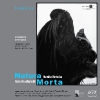NATURA MORTA Project by Robert Jankuloski and Monika Moteska
The artistic language of Robert Jankuloski and Monika Moteska fits into the broadened field of the plurivocal usage of photography in the dispersed artistic practices of the recent artistic scene in Macedonia, both in terms of expression and statement. Using photography as a “non-autonomous” discipline in the artistic practices results from a global process in which discipline purity and autonomy of the individual art media was deserted with the fading of the late modernism. The modest beginnings of the usage of this procedure in the conceptualization of the artistic language in Macedonia date from the second half of the 1980es, while in the 1990es this practice became a very important, if not a prevailing, segment of the Macedonian art scene. When the autonomy of the medium, i.e. the aura of the pure form was “silenced”, photography has become enormously usable for multiple application in the current civilization reality of the image and visual representation. The applicative usage of photography has been fulfilled based on various representation structures: iconic condensation and fetishization of the instantly recognizable images; depersonalized broadening and circulation of images in a non-expressive manner and an endless reproductive multiplication.
Robert Jankuloski and Monika Moteska’s NATURA MORTA project is dimensioned quite in the manner of this applicative usage of the photography as a medium, using its expression performances in order to create a conceptual language. The two authors already have a number of significant related projects where they have created fragmentary or mutli-narrational lines by photography or photographs, conceptualizing various aspects of artistic language and its complex history, as well as numerous current phenomena of the modern reality. This time, their joint interest focuses on a specific art area and its history, a phenomenon of the genre known in the art history as still life. The authors chose the Latin name of this genre wishing to stress its symbolic and civilization seriousness. However, the classical treatment of this genre ends there and a subtle game is opened, a layered and plurivocal play with the basic assumptions, as well as with the individual elements of the language structure that shape the iconography of still nature as a genre. With both authors there is a noticeable skillful allegoric transfer and ironic dethronization of the basic iconography of this genre in order to apply its elements in a transferred but contemporary context.
Jankuloski, as many times before, in this project uses his own photos but also photos of other authors (the old Macedonian photographers who lived in the first half of the XX century), creating an intertwined mixture, related to the idea that the image of still life can be created by various procedures and elements of the documentary recording of the reality. In this narrative concept, he composes the image and the expressive chain playing with the cemetery landscapes in which he focuses on the flowers laid on graves as an element that symbolizes life in the direct surrounding of death. This is matched by the usage of the specific photographs of the old masters in an iconography which, put in this project’s context, implies an exceptionally morbid connotation (a deceased man’s photograph by Pane Napeski and a Moslem woman’s photograph, with a barely visible part of her face by Zafir Oshafkov).
Monika Moteska uses a specific element in her project, which is a classical iconographic sign, if not a symbol, of still life genre, the dead bird. This project also uses a related procedure of estranging the genre structure and its recognizable parts. The author shows a dead stuffed bird as if alive and flying, not hiding that it is actually not alive. This subtle game of the alive and the dead, this narration of the transgression of the real to the surreal, makes its point on the photograph of a transvestite in bridal clothes. This slightly morbid mixing of various layers of reality conceptualizes a play of impossible matching as bluntly ironizing the traditional understanding of still life genre,
Valentinto Dimitrovski











